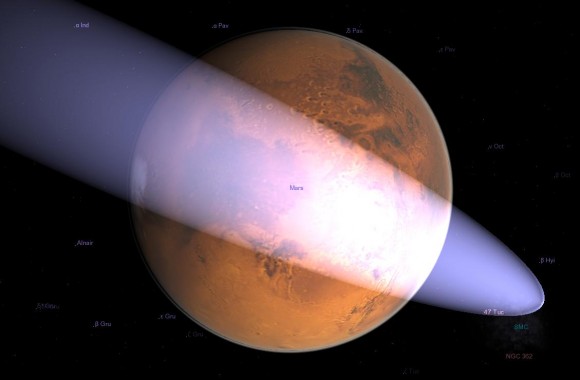The latest trajectory of comet 2013 A1 (Siding Spring) generated by the Near-Earth Object Program Office at the Jet Propulsion Laboratory indicates the comet will pass within 186,000 miles (300,000 kilometers) of Mars and there is a strong possibility that it might pass much closer. The NEO Program Office's current estimate based on observations through March 1, 2013, has it passing about 31,000 miles (50,000 kilometers) from the Red Planet's surface. That distance is about two-and-a-half times that of the orbit of outermost moon, Deimos.
Previous estimates put it on a possible collision course with Mars.
This video, above, is based on comet's orbit calculated by Leonid Elenin, which has it is coming within 58,000 km, and visualized by SpaceEngine software.
The trajectory for comet Siding Spring is being refined as more observations are made. Rob McNaught discovered this comet on Jan. 3, 2013, at Siding Spring Observatory in Australia, and looking back at archival observations has unearthed more images of the comet, extending the observation interval back to Oct. 4, 2012. Further refinement to its orbit is expected as more observational data is obtained.
"At present, Mars lies within the range of possible paths for the comet and the possibility of an impact cannot be excluded," said an update today from JPL. "However, since the impact probability is currently less than one in 600, future observations are expected to provide data that will completely rule out a Mars impact."

Siding Spring likely originated from the Oort cloud. Amateur and professional astronomers will be keeping an eye on this comet's trajectory to determine if it will end up hitting Mars or not.
Source: JPL



by Miles Mathis
...
This creates not just more light, but more heat. It creates a release of energy at all frequencies, since the energies of the cancelled spins must go somewhere. The spins sum to zero, but the energy does not. The two energies are integrated and released.
This effect is analogous to what is currently called a matter-antimatter collision. Since photons are material—they have radius and mass—they are just the smallest particles of matter. When right photons meet left photons, we get these magnetic field effects, one of which is increased brightness.
We see the same thing when electrons meet positrons, or protons meet anti-protons. According to current theory, we get annihilation in such cases, but I have shown this is false. Matter is never annihilated. When positron and electron collide, we again only get a loss of spin. Both particles are despun, so they will appear to disappear in a magnetic field. A magnetic field detection relies on particle spin, and a particle that has been despun will no longer be detected. But it has not been annihilated. The particles is still there and can be respun. I have shown experimental proof for this in other papers.
In any case, matter-antimatter collisions also cause E/M brightness, and this is known. The brightness of a retrograde comet is caused by the same basic mechanism: photon collisions, spin cancellations, energy release, and photon redirection.
...
[Link]